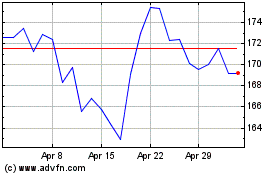Irene Caused Insured Losses Up To $400 Million In Carolinas -Eqecat
August 28 2011 - 10:20AM
Dow Jones News
Hurricane Irene may have caused up to $400 million of insured
losses in the Carolinas, according to a modeling company that
estimates the cost of natural disasters.
Eqecat Inc. estimated the hurricane caused between $200 million
and $400 million in insured losses in North and South Carolina, the
first states impacted by Irene when it made landfall Saturday.
Though massive and slow moving, Irene's damage estimate for the
Carolinas is just a fraction of the cost to the insurance industry
of Hurricane Floyd, the costliest storm in North Carolina's
history, which caused insured losses of $1.4 billion when it struck
the state in 1999.
The Eqecat estimate squares with reports from coastal points in
North Carolina, where it was reported that Irene had peeled off
roof tiles, ripped away siding and sent debris flying through
windows--but didn't manage to wipe entire neighborhoods off the
map. The storm delivered sustained winds of 85 miles an hour in
parts of the state as it crossed from Cape Lookout to Kitty Hawk
before finding the Atlantic Ocean again.
Still, Eqecat noted in an alert to clients that Irene "produced
heavier than initially expected rain totals--including up to 20
inches in North Carolina and more than 9 inches in Virginia."
The insured loss estimate doesn't include flood damage caused by
the so-called storm surge that Irene pushed inland as it advance
northward. But the surge--a tsunami-like phenomenon that's
generated by the storm--arrived at close to low tide, said Matthew
Nielsen, of Risk Management Solutions Inc., another
disaster-modeling company. That timing meant the surge didn't reach
too far inland as it washed ashore.
After Floyd, the federal government spent $463 million on claims
paid by its National Flood Insurance Program, according to the
Insurance Information Institute.
Experts cautioned late Saturday that residents in the Northeast
should still treat Irene seriously, even though Irene hadn't set
records in North Carolina. The storm was moving over New York City
Sunday morning as it headed toward Connecticut and points
north.
Insurers like Allstate Corp. (ALL), Travelers Cos. (TRV) and
USAA have positioned disaster-response teams along the East Coast
so they can begin sending adjusters to the site of damaged homes as
soon as Irene passes by.
State Farm Mutual Automobile Insurance Co. is the largest home
insurer in the states in Irene's path. Allstate ranks second by
premium revenue, and Liberty Mutual Group is third, according to
data collected by SNL Financial.
-By Erik Holm, Dow Jones Newswires; 212-416-2892;
erik.holm@dowjones.com
Allstate (NYSE:ALL)
Historical Stock Chart
From Jun 2024 to Jul 2024

Allstate (NYSE:ALL)
Historical Stock Chart
From Jul 2023 to Jul 2024
